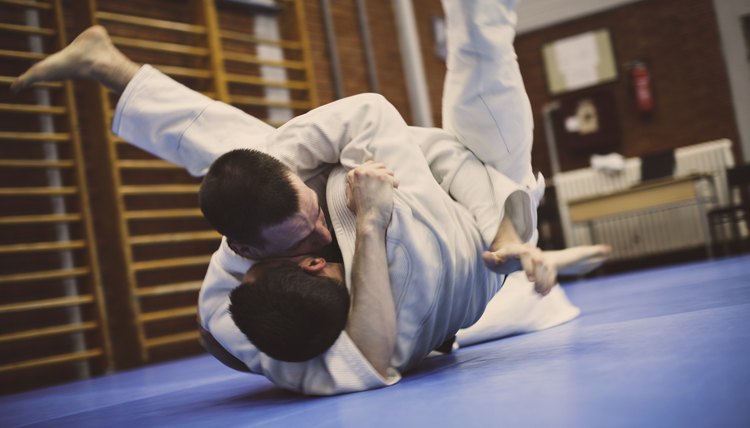What does fact checked mean?
At SportsRec, we strive to deliver objective content that is accurate and up-to-date. Our team periodically reviews articles in order to ensure content quality. The sources cited below consist of evidence from peer-reviewed journals, prominent medical organizations, academic associations, and government data.
- International Journey of Sports Physical Therapy:CURRENT CONCEPTS OF MUSCLE AND TENDON ADAPTATION TO STRENGTH AND CONDITIONING:Jason Brumitt, Tyler Cuddeford: (2015)
- International Journey of Sports Physical Therapy:CURRENT CONCEPTS OF MUSCLE AND TENDON ADAPTATION TO STRENGTH AND CONDITIONING:Jason Brumitt, Tyler Cuddeford: (2015)
- Annual review of biomedical engineering:Biomechanical and molecular regulation of bone remodeling:Robling AG1, Castillo AB, Turner CH:(2006)
- Annual review of biomedical engineering:Biomechanical and molecular regulation of bone remodeling:Robling AG1, Castillo AB, Turner CH:(2006)
- Journal of Physical Therapy Science:Effects of Ving Tsun Chinese martial art training on musculoskeletal health, balance performance, and self-efficacy in community-dwelling older adults: Lip, Ryan W.T. et al:(2015)
- Journal of Physical Therapy Science:Effects of Ving Tsun Chinese martial art training on musculoskeletal health, balance performance, and self-efficacy in community-dwelling older adults: Lip, Ryan W.T. et al:(2015)
The information contained on this site is for informational purposes only, and should not be used as a substitute for the advice of a professional health care provider. Please check with the appropriate physician regarding health questions and concerns. Although we strive to deliver accurate and up-to-date information, no guarantee to that effect is made.
How to Make Your Forearms Tougher With Martial Arts

Martial artists need tough forearms to throw punches and do impressive breaks. Discover the methods martial artists use to develop forearms that can take whatever is (literally) thrown at them.
Tough Forearms Can Hit, and Get Hit, Hard
The goal of toughening the forearms is to become less sensitive to the shock of impacts from forearm strikes or to block an opponent’s blow. Forearms that haven’t been conditioned to take impacts can end up hurting so bad that it can be disabling.
Tougher Muscles Versus Tougher Bones
According to commentary in the 2015 International Journey of Sports Physical Therapy, resistance training with weights can cause a kind of muscle damage called a microtear. With enough rest and a healthy diet, the body repairs the injury while making the muscle bigger and stronger than it was before, a process called muscular hypertrophy.
But even with the strongest muscles in the world, the body won’t increase its ability to take a hard hit. While the muscles provide some protection, they can’t prevent bones from injury when the body experiences serious trauma. Tough bones are necessary to minimize the pain or damage from an impact.
For truly tough forearms, it’s crucial to train the bones under the muscles.
How Bones Get Tougher
In the same way that muscles heal and grow stronger from repeated workouts, the bones also adapt to stress. A 2006 paper in the journal Annual Review of Biomedical Engineering explains that when bones are stressed by repeated impact, they become damaged in a way similar to the microtears muscles develop from resistance training. The structure of the bone sustains microscopic damage that the body then repairs.
Bones are composed of a honeycomb-like structure that allows the bone to compress to withstand impact better. This healing process creates a more rigid structure on a microscopic level resulting in tougher, thicker bones.
Kung-Fu Techniques for Tougher Forearms
Kung-fu practitioners have trained and practiced to gain the ability to take powerful blows and possess superior strength for attack. Chinese Kung-fu has developed hardening drills and techniques that toughen and desensitize the forearms.
Wooden rods: Kung-fu practitioners use thin wooden rods to strike their forearms repeatedly. They begin with thin rods and strike the forearms lightly, but the idea is to gradually strike them harder and use heavier sticks as the bones get tougher and stronger.
The heavy bag: The different Kung-fu styles, like other martial arts, use the heavy bag to practice strikes. By using hitting the heavy bag with forearm strikes and blocks, they’ll become less sensitive to pain and the bones will adapt to resist the damage from impact better.
A Wing-Chun dummy: The Wing-Chun dummy is a tall wooden structure with sticks protruding at different angles and heights. It represents an opponent and is used to practice strikes and blocks. A 2015 study in the Journal of Physical Therapy Science, suggests that Wing-Chun dummy practice can toughen the forearm bones and muscles.
Karate Techniques for Tougher Forearms
To toughen bone and muscle, Karate uses a traditional striking board called the makiwara. This is typically made of wood that is lightly cushioned by cloth or leather. It’s a brutal, but effective, device for making the forearms tougher with martial arts.
Like using the Wing-Chun dummy, the idea is to strike the makiwara with the forearms repeatedly over many weeks of practice to desensitize the nerves and toughen forearm bones.
References
- International Journey of Sports Physical Therapy:CURRENT CONCEPTS OF MUSCLE AND TENDON ADAPTATION TO STRENGTH AND CONDITIONING:Jason Brumitt, Tyler Cuddeford: (2015)
- Annual review of biomedical engineering:Biomechanical and molecular regulation of bone remodeling:Robling AG1, Castillo AB, Turner CH:(2006)
- Journal of Physical Therapy Science:Effects of Ving Tsun Chinese martial art training on musculoskeletal health, balance performance, and self-efficacy in community-dwelling older adults: Lip, Ryan W.T. et al:(2015)
Resources
Writer Bio
George W. Citroner is a freelance journalist covering science, medicine, and health.
